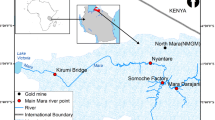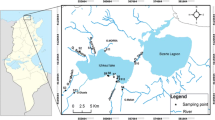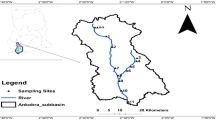Abstract
The Daliao River System (DRS) is one of the major river systems in the northeastern China and receives substantial discharges from industrial, municipal, and agricultural effluents. In this study, the contents and partition of toxic trace elements in the DRS sediments were evaluated in terms of contamination levels and ecological risks using geoaccumulation index (Igeo), relative enrichment factor (REF), sediment pollution index (SPI), and potential effect concentration quotient (PECQ). Fourteen samples were collected and measured for trace and major elements and sediment properties. The following concentration ranges (mg kg−1) of toxic trace elements were found: As, 1.6–18.0; Cd 0.1–0.9; Co 3.8–23.4; Cr 12.9–151.6; Cu 4.6–86.1; Hg 0.01–0.35; Ni 8.4–64.4; Pb 11.6–67.1; Sb 0.13–1.77; V 18.5–153.3; and Zn 20.4–211.3. The proportions of soluble and exchangeable trace metals were less than 1 %, while the proportions of trace metals bound to carbonate, amorphous oxides, organic matter, and crystalline oxides were usually each <10 %. However, 28.8 % of Cd, on average, was associated with carbonate. The average proportions of trace metals in the residual fraction ranged 57.3 % for Cd to 85.4 % for Cr, indicating low mobility and bioavailability. Cr, Ni, V, and Co in the sediments mainly originated from natural sources, while Cd, As, Pb, Sb, and Hg partially originated from anthropogenic sources. The Igeo, REF, SPI, and PECQ values of the heavy metals in the sediment were not in agreement with each another. The average REF values of Cd and As were higher than those of the other metals. However, the average PECQ value was higher for Cr and Ni than for the other metals, indicating that these two metals would cause higher adverse biological effects than the other metals. In addition, the sediments located adjacent to cities were more contaminated. Therefore, it is suggested that future management and pollution control within the DRS might focus on As, Cd, Cr, and Ni in the sediments, particularly in the sediments adjacent to cities.





Similar content being viewed by others
References
Beltrán R, de la Rosa JD, Santos JC, Beltrán M, Gómez Ariza JL (2010) Heavy metal mobility assessment in sediments from the Odiel River (Iberian Pyritic Belt) using sequential extraction. Environ Earth Sci 61:1493–1503
Bowen HJM (1979) Environmental Chemistry of the Elements. Academic Press, London
Calmano W, Wolfgang A, Förstner U (1990) Exchange of heavy metals between sediment components and water. In: Broekaert JAC, Gucer S, Adams F (eds) Metal speciation in the environment. NATO ASI Ser, Ser G 23, Berlin, pp 503–522
Cheung KC, Poon BHT, Lan CY, Wong MH (2003) Assessment of metal and nutrient concentrations in river water and sediment collected from the cities in the Pearl River Delta, South China. Chemosphere 52:1431–1440
CNMIA (China Nonferrous Metals Industry Association) (2011) Yearbook of Nonferrous Metals Industry of China, 2010. World Book Press, Beijing
Dzombak DA, Morel FMM (1990) Surface complexation modeling: Hydrous ferric oxide. Wiley, New York
Fan YH, Lin C, He MC, Yang ZF (2009) Enrichment and chemical fraction of copper and zinc in the sediments of the Daliao River System, China. Soil Sediment Contam 18:688–701
Feng JL, Wang GL, Sun JH, Sun SP, Liu XF (2010) Metals in water and surface sediments from Henan reaches of the Yellow River, China. Sci China Chem 53:1217–1224
Filgueiras AV, Lavilla I, Bendicho C (2002) Chemical sequential extraction for metal partitioning in environmental solid samples. J Environ Monit 4:823–857
Förstner U, Ahlf W, Calmano W, Kersten M (1990) Sediment criteria development—contributions from environmental geochemistry to water quality management in: Heling D, Rothe P, Förstner U, Stoffers P (eds) Sediments and environmental geochemistry: Selected aspects and case studies. Springer, Berlin, pp 311–338
Gibbs RJ (1973) Mechanisms of trace metal transport in rivers. Science 180:71–73
Han FX, Banin A (1995) Selective sequential dissolution techniques for trace metals in arid-zone soils: the carbonate dissolution step. Commun Soil Sci Plant Anal 26:553–576
Han FX, Banin A (1996) Solid-phase manganese fractionation changes in saturated arid-zone soils: pathways and kinetics. Soil Sci Soc Am J 60:1072–1080
Han FX, Banin A (1997) Long-term transformations and redistribution of potentially toxic heavy metals in arid-zone soils. I: under saturated conditions. Water Air Soil Pollut 95:399–423
Han FX, Banin A (1999) Long-term transformations and redistribution of potentially toxic heavy metals in arid-zone soils. II: under field capacity regime. Water Air Soil Pollut 114:221–250
He MC, Wang ZJ, Tang HX (1998) The chemical, toxicological and ecological studies in assessing the heavy metal pollution in Le An River, China. Water Res 32:510–518
Hejabi AT, Basavarajappa HT, Karbassi AR, Monavari SM (2011) Heavy metal pollution in water and sediments in the Kabini River, Karnataka, India. Environ Monit Assess 182:1–13
Ingersoll CG, MacDonald DD, Wang N, Crane JL, Field LJ, Haverland PS, Kemble NE, Lindskoog RA, Severn C, Smorong DE (2001) Predictions of Sediment Toxicity Using Consensus-Based Freshwater Sediment Quality Guidelines. Arch Environ Con Tox 41:8–21
Jain CK (2004) Metal fractionation study on bed sediments of River Yamuna, India. Water Res 38:569–578
Jain CK, Singhal DC, Sharma MK (2005) Metal pollution assessment of sediment and water in the river Hindon, India. Environ Monitor Assess 105:193–207
Jain CK, Gupta H, Chakrapani GJ (2008) Enrichment and fractionation of heavy metals in bed sediments of River Narmada, India. Environ Monitor Assess 141:35–47
Kim Y, Kim BK, Kim K (2010) Distribution and speciation of heavy metals and their sources in Kumho River sediment, Korea. Environ Earth Sci 60:943–952
Li XD, Wai OWH, Li YS, Coles BJ, Ramsey MH, Thornton I (2000) Heavy metal distribution in sediment profiles of the Pearl River estuary, South China. Appl Geochem 15:567–581
Lin C, He MC, Zhou YX, Hu LJ, Guo W, Quan XC, Yang ZF (2007) Mercury contamination and dynamics in the sediment of the second Songhua River, China. Soil Sediment Contam 16:397–411
Lin C, He MC, Zhou YX, Guo W, Yang ZF (2008) Distribution and contamination assessment of heavy metals in sediment of the Second Songhua River, China. Environ Monitor Assess 137:329–342
Liu WX, Li XD, Shen ZG, Wang DC, Wai OWH, Li YS (2003) Multivariate statistical study of heavy metal enrichment in sediments of the Pearl River Estuary. Environ Pollut 121:377–388
Loeppert RH, Suarez DL (1996) Carbonate and gypsum. In: Sparks DL et al (eds) Methods of soil analysis, part3. Chemical methods. SSSA and ASA, Madison, pp 437–474
Long ER, Ingersoll CG, MacDonald DD (2006) Calculation and uses of mean sediment quality guideline quotients: a critical review. Environ Sci Technol 40:1726–1736
Ma HR, Hua L, Ji JF (2011) Speciation and phytoavailability of heavy metals in sediments in Nanjing section of Changjiang River. Environ Earth Sci 64:185–192
McKenzie RM (1975) An electron microprobe study of the relationships between heavy metals and manganese and iron in soils and ocean floor nodules. Aust J Soil Res 13:177–188
MEPPRC (Ministry of Environmental Protection of the People’s Republic of China) (2005) Statistical Report of China Environments: 2004. http://www.mep.gov.cn/gzfw/xzzx/wdxz/index_1.htm
Mil-Homens M, Stevens RL, Cato I, Abrantes F (2007) Regional geochemical baselines for Portuguese shelf sediments. Environ Pollut 148:418–427
Müller G (1969) Index of geoaccumulation in sediments ofthe Rhine river. GeoJournal 2:108–118
Nasrabadi T, Bidhendi GN, Karbassi A, Mehrdadi N (2010) Partitioning of metals in sediments of the Haraz River (Southern Caspian Sea basin). Environ Earth Sci 59:1111–1117
Nelson DW, Sommers LE (1996) Total carbon, organic carbon, and organic matter. In: Sparks DL et al (eds) Methods of soil analysis, part3. Chemical methods. SSSA and ASA, Madison, pp 961–1010
Pasternack GB, Brown KJ (2006) Natural and anthropogenic geochemical signatures of floodplain and deltaic sedimentary strata, SacramentoeSan Joaquin Delta, California, USA. Environ Pollut 141:295–309
Rao CRM, Sahuquillo A, Lopez Sanchez JF (2008) A review of the different methods applied in environmental geochemistry for single and sequential extraction of trace elements in soils and related materials. Water Air Soil Pollut 189:291–333
Schwarzenbach RP, Escher BI, Fenner K, Hofstetter TB, Johnson CA, von Gunten U, Wehrli B (2006) The challenge of micropollutants in aquatic systems. Science 313:1072–1077
Singh M (2001) Heavy metal pollution in freshly deposited sediments of the Yamuna River (the Ganges River tributary): a case study from Delhi and Agra urban centres, India. Environ Geol 40:664–670
Singh M, Müller G, Singh IB (2002) Heavy metals in freshly deposited stream sediments of rivers associated with urbanization of the Ganga Plain, India. Water Air Soil Pollut 141:35–54
Singh KP, Mohan D, Singh AK, Malik A (2005) Studies on distribution and fractionation of heavy metals in Gomti river sediments—a tributary of the Ganges, India. J Hydrol 312:14–27
Sutherland RA (2000) Bed sediment-associated trace metals in an urban stream, Oahu, Hawaii. Environ Geol 39:611–627
Tessier A, Campbell PGC (1987) Partitioning of trace metals in sediments: relationship with bioavailability. Hydrobiologia 149:43–52
Tessier A, Campbell PGC, Bisson M (1979) Sequential extraction procedure for the speciation of particulate trace metals. Anal Chem 51:844–851
Turekian KK, Wedepohl KH (1961) Distribution of the elements in some major units of the earth’s crust. Bull Geol Soc Am 72:175–192
Usero J, Gamero M, Morillo J, Gracia I (1998) Comparative study of three sequential extraction procedures for metals in marine sediments. Environ Int 24:487–496
Wakida FT, Lara-Ruiz D, Temores-Peña J, Rodriguez-Ventura JG, Diaz C, Garcia-Flores E (2008) Heavy metals in sediments of the Tecate River, Mexico. Environ Geol 54:637–642
Wang SL, Lin C, Cao XZ (2011) Heavy metals content and distribution in the surface sediments of the Guangzhou section of the Pearl River, Southern China. Environ Earth Sci 64:1593–1605
Wedepohl KH (1995) The composition of the continental crust. Geochim Cosmochim Ac 59:1217–1239
Yalcin MG, Narin I, Soylak M (2008) Multivariate analysis of heavy metal contents of sediments from Gumusler creek, Nigde, Turkey. Environ Geol 54:1155–1163
Zachara JM, Cowan CE, Resch CT (1991) Sorption of divalent metals on calcite. Geochim Cosmochim Ac 55:1549–1562
Acknowledgments
This study was supported by the National Natural Science Foundation of China (40971058, 40873077) and the National Science Foundation for Innovative Research Group (51121003).
Author information
Authors and Affiliations
Corresponding author
Rights and permissions
About this article
Cite this article
Lin, C., He, M., Liu, X. et al. Distribution and contamination assessment of toxic trace elements in sediment of the Daliao River System, China. Environ Earth Sci 70, 3163–3173 (2013). https://doi.org/10.1007/s12665-013-2382-3
Received:
Accepted:
Published:
Issue Date:
DOI: https://doi.org/10.1007/s12665-013-2382-3




